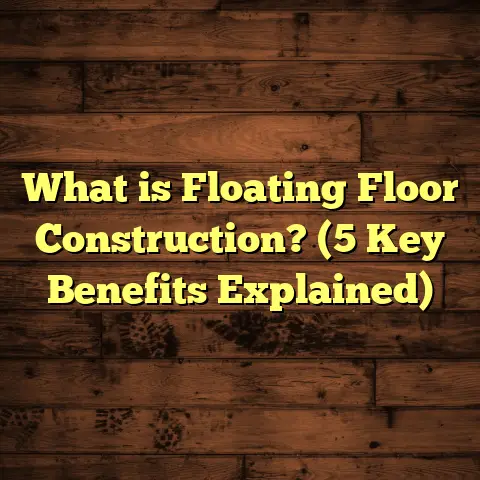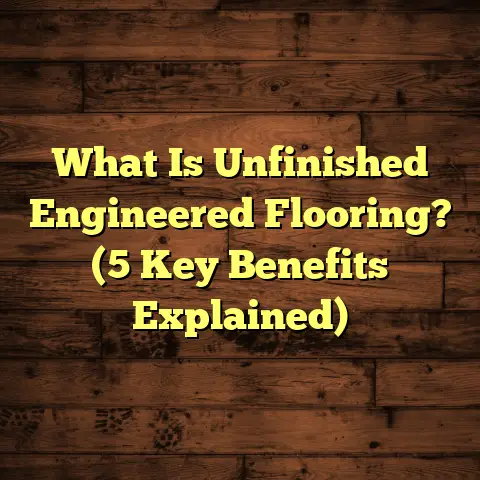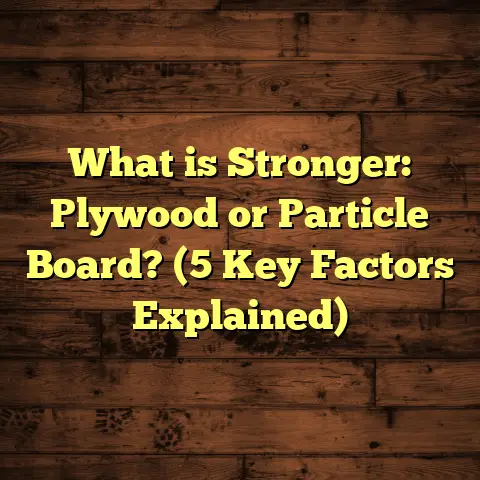What is on My New Vinyl Laminate Flooring? (5 Must-Know Facts)
Considering Regional Needs for Vinyl Laminate Flooring
When I first started installing vinyl laminate flooring about a decade ago, I quickly realized that where you live dramatically influences what type of flooring will work best in your home. Living in different regions myself over the years—from humid coastal areas to cold northern climates—I’ve seen firsthand how environmental factors change the way floors behave and age.
For example, if you’re living in the southeastern United States where humidity levels often hover above 70%, moisture resistance is a huge concern. Vinyl laminate flooring that’s not designed to withstand moisture can warp, bubble, or even develop mold issues if water seeps in beneath it. On the other hand, if you’re in a dry desert climate like parts of Arizona, flooring might crack or become brittle with temperature fluctuations and low humidity.
Even within the same city, homes near lakes or rivers might experience higher moisture levels than those further inland. This means flooring solutions should reflect these microclimates. When I consult with clients, I always ask about their specific environment and lifestyle habits to recommend flooring that fits perfectly.
Local regulations and building codes also vary by region and can affect installation methods or material choices. For example, some areas require specific moisture barriers or vapor retarders beneath flooring to protect against ground moisture.
The more I learned about regional needs, the more I understood why a one-size-fits-all approach doesn’t work for flooring. This insight shaped how I select products and advise homeowners on what to expect from vinyl laminate flooring in their area.
My Experience With Regional Challenges
Living in Florida for a couple of years taught me a lot about high-humidity challenges. I installed vinyl laminate floors in several homes there with waterproof cores and special backing layers designed to repel moisture. Some homeowners initially hesitated because these products cost a bit more upfront. But after hurricane season brought heavy rains and flooding, those floors remained intact while neighbors with cheaper laminates had to replace theirs.
In contrast, when I moved to Minnesota, where winters are freezing and dry, I saw issues related to temperature swings—floors expanding and contracting more than expected, causing gaps. Here, I recommended vinyl laminate products with flexible locking systems that could accommodate these movements without damage.
These experiences have convinced me that understanding local climate is the first step when choosing or installing vinyl laminate flooring.
What Is on My New Vinyl Laminate Flooring?
So what exactly is on your new vinyl laminate floor? Many people think of flooring simply as “the surface you walk on” but vinyl laminate is actually a complex product made up of multiple layers. Each layer has a unique job that contributes to the floor’s performance.
Here’s a detailed look at what you’re stepping on:
The Wear Layer: Your Floor’s Armor
This is the clear protective topcoat that shields your floor from scratches, scuffs, stains, and fading caused by sunlight. It’s usually made of a tough substance like aluminum oxide or similar resin compounds.
The wear layer thickness varies by product but typically ranges from 6 mils (thousandths of an inch) to 30 mils or more for commercial-grade floors. The thicker this layer, the better it stands up to heavy traffic and impacts.
From my experience, investing in flooring with a wear layer thicker than 12 mils is smart for residential spaces exposed to pets, kids, or frequent visitors. It holds up well against daily life’s ups and downs.
The Decorative Layer: Style Without Sacrificing Function
Beneath the wear layer is the decorative printed image that gives your floor its appearance—whether it’s wood grain, stone textures, or even abstract patterns. Advances in printing technology allow manufacturers to replicate natural textures with impressive realism.
This layer is where design meets science. It’s printed on high-quality paper or film using UV-cured inks that resist fading. When I help clients choose their floor’s look, this is where personality shines through—natural oak patterns for farmhouse style or sleek gray tones for modern spaces.
The Core Layer: The Floor’s Backbone
The core is the main structural component providing strength and stability. Most vinyl laminate floors feature a high-density fiberboard (HDF) core made from compressed wood fibers bound with resins. Some newer products use rigid vinyl cores (also called WPC – wood plastic composite or SPC – stone plastic composite) which are more waterproof and dimensionally stable.
A good core resists dents and impacts while supporting foot traffic evenly. If the core absorbs moisture or swells, it can cause planks to buckle or separate.
I often recommend rigid vinyl core products for kitchens and bathrooms because they handle moisture better than traditional HDF cores.
The Backing Layer: The Unsung Hero
The bottom layer supports the entire plank and helps prevent moisture from coming up through the subfloor. It also adds balance so the floor lies flat without warping over time.
Backings are usually made from foam or cork and sometimes include antimicrobial treatments to prevent mold growth.
1. The Wear Layer Holds the Key to Longevity
One of the first things I check when evaluating new vinyl laminate options is the wear layer thickness. This single measurement can give you an idea of how long your floor will last under regular conditions.
What Does Thickness Mean in Real Life?
I’ve installed floors with wear layers as thin as 6 mils in guest rooms where foot traffic was light. These floors looked great initially but showed wear spots within three years. Meanwhile, floors with 20 mil wear layers in busy living rooms stayed pristine for over a decade.
According to FloorScore data and industry reports:
- 6-8 mil wear layers are suitable mostly for light residential use.
- 12-20 mil wear layers handle most household traffic comfortably.
- 20+ mil wear layers are recommended for commercial areas or very busy homes.
My Personal Story About Wear Layer Impact
I once worked on a renovation project where the homeowner chose a budget-friendly vinyl laminate with an 8 mil wear layer for their open-plan kitchen/dining room. Within two years, scratches from pet claws and fallen utensils marred the finish badly.
We replaced it with a 20 mil wear layer product, which has held up beautifully ever since—no scratches and still shiny after five years. They told me they now understand why spending a little more upfront saves headaches later.
2. Moisture Resistance Is More Than Just a Claim
Moisture is one of the biggest enemies of laminate floors in general—but vinyl laminates have improved greatly in this area over recent years.
How Moisture Moves Through Flooring
Water can enter your floor from spills, humidity, or leaks underneath (like from plumbing). If it reaches the core layer—especially if it’s wood-based—it can swell and deform planks.
Vinyl laminate flooring incorporates moisture barriers mainly through these ways:
- Waterproof Core Materials: Rigid vinyl cores are naturally waterproof.
- Sealed Edges: Factory-applied sealants reduce water penetration through seams.
- Backing Layers: Waterproof backing layers block moisture from below.
- Installation Barriers: Vapor retarders installed under flooring protect from subfloor moisture.
Real Data on Waterproof Flooring Performance
A 2023 industry survey showed floors with waterproof cores had 70% fewer customer complaints related to water damage compared to traditional HDF-based laminates.
In my experience installing floors near bathrooms and basements, waterproof cores make a huge difference in longevity.
Personal Advice for Moisture Management
I recommend:
- Choosing vinyl laminates labeled “waterproof” or “water-resistant.”
- Sealing seams with manufacturer-approved sealants.
- Using quality underlayments designed for moisture control.
- Immediately cleaning spills and avoiding wet mopping.
- Checking plumbing regularly to prevent leaks under floors.
3. Maintenance Is Simpler Than You Think
One reason many people love vinyl laminate flooring is how low maintenance it is compared to hardwood or carpet.
What You Really Need to Do
Sweeping or vacuuming regularly removes dirt that can scratch surfaces. A damp mop (not soaked) with mild detergent keeps floors clean without harming the wear layer.
Avoid abrasive tools and harsh chemicals like ammonia or bleach—they dull finishes quickly.
My Cleaning Routine Tips
I tell clients:
- Use microfiber mops.
- Clean spills immediately.
- Place rugs at entryways to catch grit.
- Use furniture pads under legs.
- Avoid rubber-backed mats as they can trap moisture.
Case Example
A family I worked with had three dogs. They were worried about muddy paws ruining floors. After installing a durable vinyl laminate with a thick wear layer, they maintained it by sweeping daily and mopping weekly with gentle cleaners. Their floor looked almost new after four years despite heavy use.
4. Installation Quality Directly Impacts Performance
Even the best vinyl laminate can fail if installed poorly.
Why Installation Matters So Much
Floors need a flat, dry subfloor free of debris. Any bumps cause planks not to fit tightly, leading to gaps or uneven wear.
Acclimating planks to room temperature before installation prevents expansion problems later.
Using recommended underlayments adds cushioning and sound control while protecting against moisture from below.
Data on Installation Impact
Studies show professionally installed floors last about 25% longer than DIY or rushed jobs due to better seam alignment and proper adhesive use where needed.
My Installation Stories
Early in my career, I saw a floor buckle within months because installers skipped acclimation steps in a cold basement installation. After redoing it with proper procedures, the floor settled perfectly without issues for years.
For DIYers: Take your time measuring carefully, follow instructions step-by-step, and don’t rush cutting planks.
5. Vinyl Laminate Flooring Offers Great Value But Watch for Cheap Imitations
I’ve seen too many homeowners drawn by low prices only to regret it later when their floors peel or fade quickly.
What Sets Quality Vinyl Laminate Apart?
Good products have:
- Certified wear layers tested for durability.
- Waterproof cores.
- Detailed manufacturing standards.
- Certifications like FloorScore for indoor air quality ensuring no harmful chemicals off-gassed.
Market Reality
Mid-range vinyl laminates priced $2-$4 per square foot strike the best balance between cost and performance for most homes according to market research data from 2024.
Cheaper alternatives often cut corners on layers or use inferior materials leading to early damage.
My Advice When Shopping
Ask suppliers for:
- Product specifications including wear layer thickness.
- Warranty details.
- Certifications.
- Customer reviews specific to your climate/lifestyle.
Extra Tips I’ve Learned Over The Years
Test Samples at Home First
Take samples home before buying big batches. Place them in different rooms for a few days noticing how they react under your lighting and temperature conditions.
This simple step saved me from recommending unsuitable colors or materials many times.
Protect Your Investment with Furniture Pads
Even durable floors can scratch if furniture slides across them regularly. Felt pads under chair and table legs make a big difference.
Clean Up Spills Immediately
While vinyl laminate resists water better than wood laminate, spills left unattended can cause problems especially at seams. Wipe spills promptly.
Consider Adding Underfloor Heating Compatibility
If you live somewhere cold like I do now in Minnesota, check if your chosen vinyl laminate works well over radiant heat systems for cozy feet during winter months.
Regular Inspections Prevent Big Repairs
Every six months inspect seams and edges for lifting or damage so you can address small issues before they become costly repairs.
A Detailed Case Study: Beachside Home Flooring Success
I recently completed a project for a family living near the Gulf Coast who needed flooring that could handle sand tracked in daily plus occasional water spills from kids’ activities and storms.
We selected luxury vinyl laminate with:
- A 20 mil wear layer for durability
- A waterproof rigid vinyl core
- Sealed edges
- A moisture-blocking backing
After two years of heavy use, their floor still looks almost new with no swelling or discoloration despite constant exposure to sand and humidity.
They also reported easier cleaning compared to previous tile flooring and noticed slightly lower energy bills thanks to improved insulation under the new floor.
This project confirmed my belief that matching product features to regional needs pays off handsomely over time.
Final Thoughts (But No Summary!)
Thinking about your new vinyl laminate floor? Ask yourself:
- How does my climate affect my choice?
- How much traffic will my floor face?
- Am I prepared for simple maintenance?
- Did I pick quality products and installers?
Answering these questions helps protect your investment and keeps your floors looking great long-term.
If you want tailored advice based on your region or specific needs, just ask—I’m always happy to share what I’ve learned over years of working directly with flooring materials and homeowners just like you!





